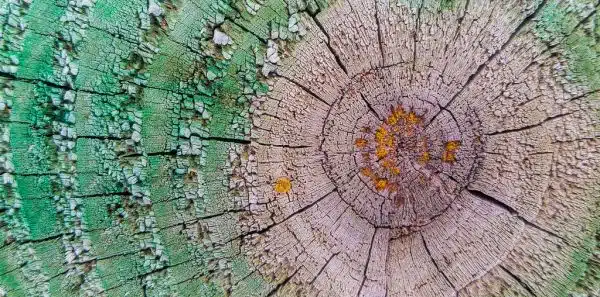As a paint and stain expert, I am often asked the question: Can you stain over paint? The answer is not as straightforward as one might think. While it is possible to apply stain over paint, there are several factors that need to be taken into consideration before doing so. In this article, I will delve into the various scenarios where staining over paint may or may not be feasible, and offer some tips on how to achieve the best possible results.
Before we explore the intricacies of staining over paint, it is important to understand the differences between these two finishes. Paint creates a solid film over the surface it is applied to, while stain penetrates the surface and enhances its natural grain and character. Therefore, applying stain over paint can result in less-than-ideal outcomes if certain conditions are not met. It is my hope that after reading this article, you will be better informed about when and how to successfully stain over paint for a beautiful finish that will serve your needs for years to come.
Understanding The Differences Between Paint And Stain
Paint vs. Stain: Pros and Cons
Paint and stain are both used to protect and enhance the appearance of surfaces, but they work in different ways. Paint is a thicker coating that completely covers the surface, creating a barrier that can block moisture and other substances from penetrating the material underneath. However, it can also trap moisture and cause rot or mildew if not applied correctly or maintained regularly. Stain, on the other hand, penetrates the surface and enhances its natural color and texture while providing protection against UV rays, water damage, and fading.
Different Types of Stains and Their Uses
There are several types of stain available on the market, each designed for specific applications. For instance, oil-based stains are ideal for exterior woodwork as they penetrate deep into the fibers of the wood to provide long-lasting protection against harsh weather conditions. Water-based stains are suitable for indoor use as they dry quickly and emit fewer fumes than oil-based products. Gel stains are thicker than other types of stains and are perfect for vertical surfaces such as doors or cabinets as they do not drip or run like liquid stains.
Factors to Consider Before Staining Over Paint
Staining over paint might seem like an easy way to refresh an old surface without having to strip off all of the existing paint first. However, several factors must be considered before attempting this process. First, it is essential to ensure that the paint is in good condition before applying any stain over it; otherwise, you risk trapping moisture under the new layer of product. Second, you need to choose a stain that is compatible with your existing paint; otherwise, it may not adhere properly or create a blotchy appearance. Finally, you need to prepare the surface thoroughly by cleaning it with soap and water or sanding it down to remove any loose paint chips or debris before applying any new products.
Factors To Consider Before Staining Over Paint
Before staining over paint, it is crucial to consider certain factors to ensure that the end result is satisfactory. One of the most critical factors when staining over paint is paint compatibility. It is essential to check if the type of paint used on the surface can accept a stain. Some paints may form a seal that prevents the absorption of stains, while others may contain chemicals that react negatively with stains.
Surface preparation also plays a vital role in staining over paint. The surface needs to be clean, dry, and free from any contaminants such as dirt, grease, or wax. Any existing peeling or loose paint should be removed by sanding or scraping down to bare substrate before applying a stain. Failing to prepare the surface adequately may result in adhesion problems and poor stain penetration.
To ensure proper preparation and application of a stain over paint, it is advisable to seek professional advice. A professional paint and stain expert can help determine whether staining over paint is suitable for your project and recommend appropriate products. Furthermore, they can provide guidance on proper surface preparation techniques and application procedures.
Assessing the condition of the painted surface is an integral step before proceeding with staining over paint. This involves examining the surface for any signs of damage such as cracks or peeling. Additionally, it would be best if you evaluated the color of the existing paint since it could affect the final outcome of your project. By taking these steps into account before starting your project, you can achieve optimal results when staining over paint without compromising its quality or longevity.
Assessing The Condition Of The Painted Surface
Before you decide to stain over painted surfaces, it is essential to assess the condition of the surface. Proper surface preparation techniques are vital in ensuring that your project is successful. Assessing adhesion is one way to determine if the paint on the surface will hold up when stained over it.
There are a few ways to test for adhesion before staining over paint. One method involves using a piece of tape to pull off some paint from the surface. If the paint comes off easily, then it’s an indication that the adhesion is weak and may not hold up after staining. Another technique involves lightly sanding the surface with fine-grit sandpaper and observing if any paint flakes off during or after sanding.
If you find that the painted surface has good adhesion and is in good condition, then you can move forward with preparing it for staining. Surface preparation techniques such as cleaning, sanding, and priming are essential in achieving optimal results. A clean surface ensures maximum penetration of stains into wood fibers, while sanding smoothens rough spots and removes any loose or flaking paint chips. Priming helps to seal porous surfaces, such as bare wood or previously stained areas.
Choosing the right type of stain for your project is crucial in achieving desirable results. Factors such as durability, color retention, and transparency should be considered when selecting stains. It’s also essential to choose a stain that complements the existing painted colors on your project’s surfaces. In addition, selecting a high-quality stain can help protect your project’s surfaces from wear and tear while enhancing its overall appearance.
Choosing The Right Type Of Stain For The Job
As a paint and stain expert, I know that staining over paint is possible. However, choosing the right brand of stain is crucial to achieving a professional finish. Not all stains are created equal, and some may not adhere well to painted surfaces. When choosing a stain for this job, it’s important to select one that is specifically designed to be used over paint.
One tip for achieving a professional finish when staining over paint is to properly prepare the surface beforehand. This means cleaning the area thoroughly and removing any loose or peeling paint. Additionally, it’s essential to sand the surface lightly before applying the stain. This will help rough up the painted surface and provide better adhesion for the stain.
Another important factor to consider when staining over paint is how much coverage you need. Some stains are more opaque than others, so if you’re looking for complete coverage, choose an opaque or solid color stain. If you want some of the underlying color or texture of the painted surface to show through, opt for a semi-transparent or translucent stain. With these tips in mind, you can achieve a beautiful and long-lasting finish when staining over paint. In preparing the surface for staining, there are several steps to follow that will ensure optimal results.
Preparing The Surface For Staining
When it comes to staining over paint, there are a few things to consider. While it’s technically possible to do so, it may not be the best idea in all cases. For example, if the existing paint is in poor condition or not adhering well, there’s a risk that the stain won’t take properly and could peel or flake off over time. On the other hand, if the paint is in good condition and you’re looking for a way to change the color or add more depth to your woodwork, staining over it can be an effective solution.
Before you begin any staining project, however, it’s important to ensure that the surface is properly prepared. This typically involves sanding down the existing paint layer using progressively finer grits of sandpaper until you reach a smooth surface that’s free of any peeling or rough spots. Depending on how many layers of paint you’re dealing with and how thick they are, this may require some elbow grease and patience. Once you’ve sanded down the surface sufficiently, use a tack cloth or vacuum cleaner to remove any dust particles before proceeding.
If sanding alone isn’t enough to get rid of all traces of old paint from your woodwork, you may need to use chemical strippers as well. These products work by breaking down the molecular bonds between the paint and wood fibers so that they can be easily scraped away with a putty knife or scraper tool. However, it’s important to follow all safety precautions when using these products since they can be hazardous if misused. Always wear gloves and protective eyewear when handling chemical strippers and work in a well-ventilated area away from open flames or sparks.
In order to achieve a beautiful stained finish on your woodwork, taking care during preparation is key. By carefully sanding down all traces of old paint and using chemical strippers only when necessary, you can create a smooth surface that will readily accept the stain and showcase the natural beauty of your wood. In the next section, we’ll explore some of the best sanding and stripping techniques to use for different types of woodwork and paint conditions.
Sanding And Stripping Techniques
- Sandpaper grades range from coarse to fine, and can be used to achieve a range of finishes from rough to smooth.
- Chemical stripping is a common method of removing paint and varnish from wood surfaces, but can cause damage if not used correctly.
- Power sanding is an efficient method of material removal, but can result in uneven surfaces if not used with care.
- For best results, it is important to select the proper grade of sandpaper for the job, taking into account the desired finish and the amount of material that needs to be removed.
- Chemical strippers should be used in well-ventilated areas, and the instructions should be followed carefully to avoid damaging the surface.
- Power sanders should be used with caution to avoid damaging the surface and to ensure an even finish.
Sandpaper Grades
When it comes to achieving a smooth finish on your painted surfaces, choosing the right sandpaper grades is crucial. The process of sanding is an important step in surface preparation and can make or break the final outcome of your project. Therefore, it is essential to understand the different sandpaper grades available and when to use them for optimal results.
Choosing sandpaper grades depends on the type of material you are working with and the level of surface preparation needed. For instance, if you are looking to remove old paint or roughen up a surface for better adhesion, you may need to start with coarse grits like 60 or 80. On the other hand, if you are looking to smooth out a previously sanded surface or create a polished finish, you may need to use finer grits like 220 or higher.
Sanding techniques also play a critical role in achieving your desired results. It is important to apply even pressure while sanding and avoid over-sanding any one area as this may cause unevenness in the finished product. Additionally, always remember to clean off any dust or debris from the sanded surface before proceeding with painting or staining. By following these sanding techniques and selecting appropriate sandpaper grades for surface preparation, you can achieve a beautiful finish that lasts for years to come.
Chemical Stripping
When it comes to preparing surfaces for painting or staining, sanding is not always the best option. For particularly stubborn layers of paint or coatings, as well as intricate or hard-to-reach areas, chemical stripping may be a more effective solution. Chemical stripping involves applying a specialized solution to break down and dissolve the existing finish, making it easier to remove without damaging the underlying surface.
There are several benefits to using chemical stripping over traditional sanding techniques. For one, it can save time and effort by reducing the amount of physical labor required. It can also be more precise in removing specific layers of coating without damaging other parts of the surface. Additionally, some types of finishes may contain hazardous materials like lead or asbestos that pose health risks when sanded; chemical stripping can help avoid these issues.
While chemical stripping can be a powerful tool in surface preparation, it is important to use caution and follow safety guidelines when handling these substances. Always wear appropriate protective equipment like gloves and goggles and work in a well-ventilated area. It is also important to research alternative techniques and choose the best method for your specific project needs to ensure optimal results.
Power Sanding
When it comes to surface preparation for painting or staining, sanding is one of the most commonly used techniques. However, traditional sanding can be time-consuming and labor-intensive, especially for larger surfaces. This is where power sanding comes in as a more efficient alternative. Power sanding involves using specialized equipment that rotates rapidly to quickly remove layers of paint or coatings from a surface.
There are several benefits to using power sanding over traditional hand-sanding techniques. First and foremost, it can save a significant amount of time and effort while still achieving a smooth and even surface. It also allows for greater precision and control when working on intricate details or hard-to-reach areas. Some types of power sanders even come with built-in dust collection systems which can help minimize cleanup and reduce the risk of inhaling harmful particles.
When using power sanders, it is important to have the appropriate equipment on hand. This includes not only the sander itself but also various types of abrasives such as sandpaper or discs, depending on the type of surface being worked on. Safety should also be a top priority; always wear protective gear like goggles and earplugs, work in a well-ventilated area, and follow all manufacturer instructions for proper use.
In conclusion, power sanding is an effective technique for preparing surfaces for painting or staining that offers several benefits over traditional hand-sanding methods. With the right equipment and safety precautions in place, it can be a valuable tool for achieving optimal results in less time and with less physical strain.
Applying A Bonding Primer
Imagine a blank canvas awaiting your creative touch. You can envision the final product, but first, you must prepare the surface to ensure it’s ready for your masterpiece. Applying paint on top of an existing layer is not always ideal; however, with the proper technique and product, you can achieve excellent results. In this section, we will discuss how applying a bonding primer can make all the difference in achieving a professional finish.
Bonding primer benefits:
- Creates a strong adhesive bond between paint and substrate
- Increases durability and protects against chipping or peeling
- Enhances color richness and vibrancy
When applying bonding primer, it’s essential to follow these techniques:
Clean the surface thoroughly: Remove any dirt, dust, grease or loose paint from the surface using warm soapy water and a stiff brush.
Apply Primer Evenly: Using a high-quality brush or roller, apply an even coat of bonding primer over the entire surface area.
Allow Drying Time: Once applied, allow sufficient drying time before applying additional coats of paint or stain.
By using a bonding primer before applying stain or paint over an existing layer, you can ensure that your final product looks polished and professional. However, before moving on to selecting the right stain color for your project, it’s crucial to understand how different stains interact with various surfaces.
Selecting The Right Stain Color
Applying a bonding primer onto painted surfaces can enhance the adhesion of the stain. However, some may wonder if it’s possible to skip this step and directly apply a stain on top of paint. The answer is yes, but with some caveats. Staining over paint is feasible as long as the surface is clean, dry, and in good condition.
Before staining over paint, ensure that the existing color won’t affect the new one. Color matching is critical to achieve desirable results. If you’re unsure about which shade to choose, consider getting color swatches from your local hardware store and hold them against the painted surface. This will give you an idea of how the stain will look like once applied.
Once you’ve selected the right stain color, it’s always best to test it on a small area before proceeding with the entire project. This step allows you to determine if there are any compatibility issues between the paint and stain or if there are any unexpected results that may arise from combining these two products. Testing also helps you adjust the application process or color selection accordingly for better outcomes. Remember that preparation is key in achieving a successful staining project – taking extra care in each step will ensure that your efforts will last for years to come.
Testing The Stain On A Small Area
Imagine you’re a chef preparing a new recipe for the first time. You wouldn’t want to serve it to guests without doing a taste test first, right? The same goes for staining over paint. Before committing to staining an entire surface, it’s important to test the stain on a small area first. This way, you can get an idea of how the stain will look and whether it will adhere properly.
There are benefits and drawbacks to testing the stain on a small area. On one hand, if the stain doesn’t adhere properly or looks different than expected, you won’t have wasted time and money staining the entire surface. On the other hand, if the small area looks great but the rest of the surface doesn’t turn out as well, it may be difficult to fix without redoing everything.
To ensure accurate results during the testing process, follow these four steps:
- Clean: Ensure that your surface is clean and dry before applying any stain.
- Sand: Lightly sand the surface to remove any loose paint or debris.
- Test: Apply a small amount of stain in an inconspicuous area and wait for it to dry completely.
- Assess: Evaluate how well the stain adhered and whether it looks how you expected before proceeding with staining the entire surface.
Testing is an essential step when considering staining over paint. By taking this precautionary measure, you can avoid costly mistakes and ensure that your finished product looks exactly how you envisioned it. In the next section, we’ll discuss how to apply stain once you’ve completed this critical step.
Applying The Stain
After testing the stain on a small area, it’s time to move on to the next step – applying the stain. Applying techniques can vary depending on the type of stain you’re using and the surface you’re staining. However, there are some general tips that can help you achieve a successful outcome.
Firstly, make sure to clean and prepare the surface before applying the stain. This will ensure that the stain adheres properly and evenly. Secondly, apply the stain in thin coats using a brush or rag, following the manufacturer’s instructions for drying time between coats. Finally, pay attention to any drips or uneven areas and smooth them out with a clean brush or rag.
When it comes to color choices for staining over paint, there are many options available. It’s important to consider both personal preference and practicality when choosing a color. Darker stains can provide better coverage over previous paint colors, while lighter stains may require more coats for even coverage. Additionally, some stains may have tinting options available for customization.
In order to achieve an even finish when staining over paint, it’s crucial to follow proper application techniques and pay attention to detail throughout the process. By taking these steps into consideration and carefully selecting your color choices, you can successfully transform painted surfaces into beautifully stained ones.
Achieving An Even Finish
Applying stain over paint can be a tricky process, but with the right techniques, it is possible to achieve a beautiful and even finish. However, common mistakes such as not preparing the surface properly or using the wrong type of stain can lead to unsatisfactory results. To ensure success, follow these tips:
Firstly, clean and prepare the surface thoroughly before staining. This includes removing any dirt, dust or debris from the surface using a suitable cleaner. If there are any cracks or holes in the paint layer, use a filler to smooth out the surface. Once your surface is clean and free of any imperfections, you can begin applying your stain.
Secondly, use a high-quality stain that is specifically designed for use over painted surfaces. Avoid using oil-based stains on top of water-based paints and vice versa. Always read the manufacturer’s instructions carefully before beginning your project.
Thirdly, apply your stain evenly and in thin coats. Start by brushing or rolling on a small amount of stain onto one section of your surface and then immediately wipe away any excess with a clean cloth. Apply additional coats until you achieve your desired level of color depth. Remember to allow each coat to dry completely before applying another.
Troubleshooting Tips:
- If you notice streaks or uneven spots after applying your stain, try sanding down those areas lightly and reapplying another coat.
- It’s important to wear protective gear such as gloves and eye protection when working with stains as they can be harmful if inhaled or absorbed through the skin.
- Always work in well-ventilated areas to avoid inhaling fumes.
With these tips in mind, achieving an even finish when staining over paint is possible. In the next section, we’ll discuss how to protect your stained surface from damage so that it lasts for years to come.
Protecting The Stained Surface
Achieving an even finish is only half the battle when it comes to staining over paint. The other half is maintaining that beautiful stained surface. While there are many protecting techniques available, there are a few maintenance tips worth noting to keep your stained finish looking its best.
One interesting statistic to consider is that 90% of stains fail due to improper maintenance. To avoid this, it’s important to keep your stained surface clean and free from any debris or dirt. Regular cleaning with a mild detergent and water can help prevent the buildup of grime and keep your stain looking fresh.
In addition to regular cleaning, it’s also important to protect your stained surface from harsh elements such as direct sunlight and moisture. Applying a clear coat or sealant can provide an extra layer of protection against these elements. However, be sure to choose a product specifically designed for use over stain as some types of sealants may cause discoloration or peeling.
To maintain the stained finish, be sure to follow these protecting techniques and maintenance tips diligently. With proper care, your stained surface will continue to look beautiful for years to come.
Maintaining The Stained Finish
Maintenance tips for stained finishes are crucial to ensure the longevity and beauty of the surface. Firstly, it is essential to clean the surface regularly with a mild soap solution and water. Abrasive cleaners should not be used as they can scratch or damage the finish. Secondly, any spills or stains should be wiped up immediately to prevent them from setting in and causing permanent damage to the stain. Lastly, it is recommended to apply a protective coat of polyurethane every few years to maintain the stain’s luster.
Common mistakes when maintaining a stained finish include using harsh chemicals or abrasive materials while cleaning, excessive exposure to direct sunlight or humidity, and neglecting routine maintenance. These mistakes can cause discoloration, peeling, cracking, or fading of the stain. It is advisable to follow manufacturer instructions for cleaning and maintenance to avoid such issues.
When staining over paint is not recommended depends on various factors like the type of paint used, its condition, and compatibility with the new stain product. In general, if there are multiple layers of paint on a surface or if it’s flaking or peeling off, then it’s best to remove all the paint before staining. Applying new stain over old paint can lead to uneven color results and poor adhesion. In case of doubt about whether staining over paint is feasible for your project, consult with a professional painter who can guide you through all available options for achieving your desired outcome.
When Staining Over Paint Is Not Recommended
Imagine trying to plant a beautiful garden in a field filled with rocks and debris. No matter how much time and effort you put into it, the end result will not be what you envisioned. Similarly, attempting to stain over certain types of paint can lead to disappointing results. While some may believe that painting and staining are interchangeable processes, there are certain types of paint that should not be stained over.
One such type is latex or acrylic paint. These types of paint create a non-porous surface that prevents stain from penetrating properly. In addition, the stain may not adhere well to the paint surface and may peel or flake off over time. Another type of paint to avoid staining over is glossy or semi-glossy paints as they can also create a barrier that prevents proper absorption.
It’s important to note that even if the right type of paint is used, certain types of stains should still be avoided when attempting to stain over paint. For example, water-based stains may not adhere well to oil-based paints and vice versa. In addition, gel stains can be too thick and opaque for use on painted surfaces. By avoiding these common mistakes, homeowners can ensure a successful staining project that enhances their home’s appearance without sacrificing quality or longevity.
Moving forward with expert tips and tricks for staining over paint, there are several key considerations to keep in mind before beginning any project. By properly preparing the surface area through sanding and cleaning, using the right tools for application, and selecting compatible products such as oil-based stains for oil-based paints, homeowners can achieve professional-level results without needing professional expertise.
Expert Tips And Tricks For Staining Over Paint
Staining over paint can be done, but it is important to consider the pros and cons before proceeding with this option. One advantage of staining over paint is that it can give a unique look to the surface. Additionally, it can help to protect the underlying paint from wear and tear.
However, there are also some common mistakes that people make when attempting to stain over paint. One mistake is not properly preparing the surface before applying the stain. This can result in an uneven finish or even cause the stain to peel off over time. Another mistake is using the wrong type of stain for the particular type of paint that was used.
To avoid these mistakes, there are several expert tips and tricks that can be followed when staining over paint. These include thoroughly cleaning and sanding the surface before applying any stain, using a high-quality primer to ensure proper adhesion of the stain, and selecting a stain that is compatible with the type of paint used on the surface.
Overall, staining over paint can be a great option for those looking to give their surfaces a unique look while also providing added protection. However, it is important to carefully consider both the pros and cons as well as follow expert tips and tricks in order to achieve the desired results.
Conclusion
When it comes to staining over paint, there are several factors to consider. Understanding the differences between paint and stain is crucial in determining whether or not this is a feasible option for your project. Additionally, assessing the condition of the painted surface and choosing the right type of stain are essential steps in achieving a successful outcome.
Before starting, it is important to prepare the surface properly and protect the stained finish once complete. However, staining over paint may not always be recommended depending on the specific circumstances of your project. It is vital to consult with an expert or conduct thorough research before proceeding with this process.
One anticipated objection to staining over paint is that it may result in an uneven or inconsistent finish. While this can be a valid concern, proper preparation and technique can greatly minimize these risks. By following best practices and taking necessary precautions, you can achieve a beautiful and long-lasting stained finish over previously painted surfaces.
Image Credits
- “Decaying stained wood post” by FotoGrazio (featured)





























